Latin America Digital Signage Market Size
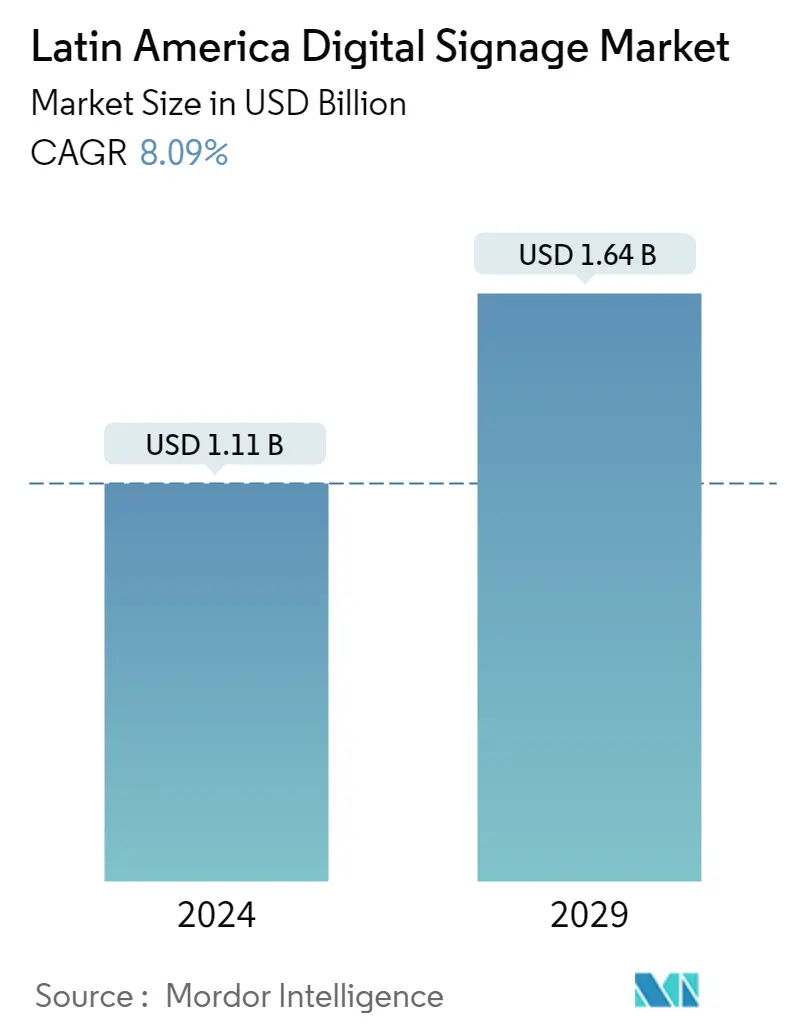
| Study Period | 2019 - 2029 |
| Base Year For Estimation | 2023 |
| Market Size (2024) | USD 1.11 Billion |
| Market Size (2029) | USD 1.64 Billion |
| CAGR (2024 - 2029) | 8.09 % |
| Market Concentration | Low |
Major Players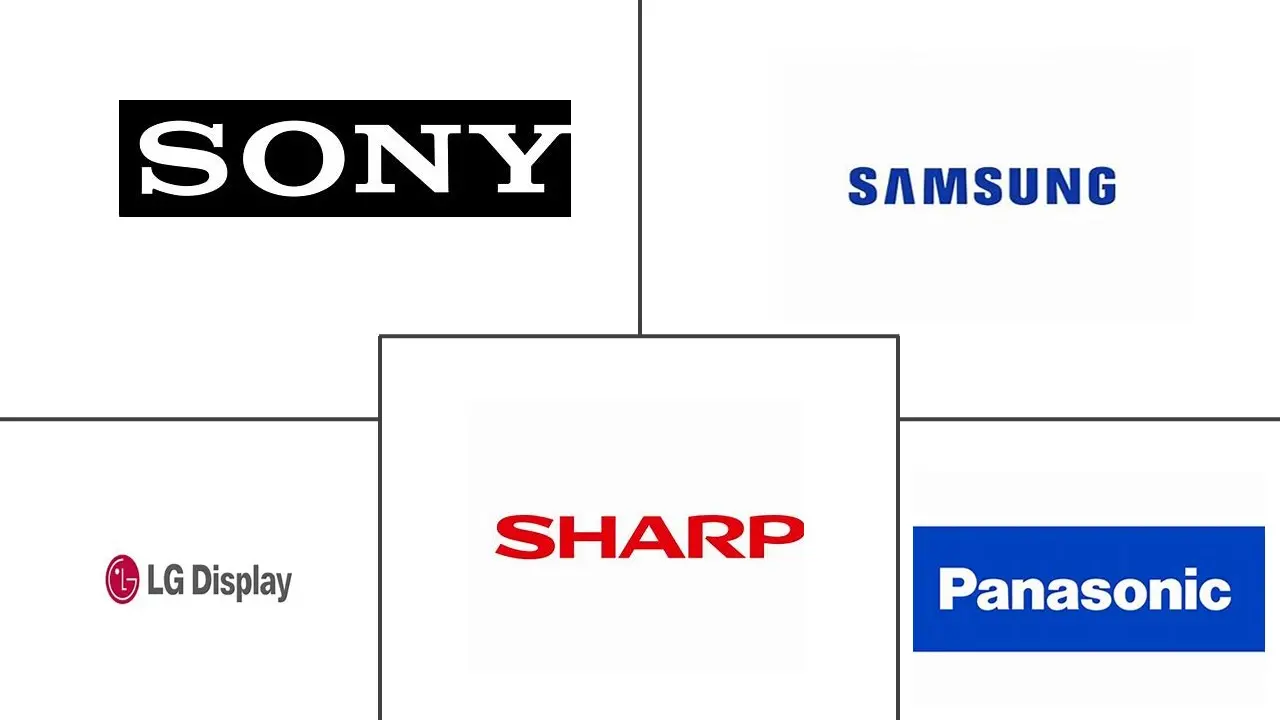
*Disclaimer: Major Players sorted in no particular order |
Need a report that reflects how COVID-19 has impacted this market and its growth?
Latin America Digital Signage Market Analysis
The Latin America Digital Signage Market size is estimated at USD 1.11 billion in 2024, and is expected to reach USD 1.64 billion by 2029, growing at a CAGR of 8.09% during the forecast period (2024-2029).
- Digital signage enables vendors in the region to change the displays and messages more quickly and let the content reach potential customers cost-effectively and efficiently. Furthermore, it is easy to manage when compared to traditional advertisements. Digital signs offer real-time information on products and availability, interactive data, and visually enticing photos and videos.
- The increased spending on digital advertising in the Latin American region is expected to create further significant opportunities for the growth of the digital signage market. Digital outdoor signage is one part of the audio and visual market that has grown steadily over the last decade, and that growth is only accelerating. Digital outdoor signage is used in almost every industry, with applications in restaurants and hotels, retail places, transit facilities, and entertainment events.
- Furthermore, increasing collaborations are expected to aid the solution providers in providing innovative solutions to customers. For instance, the Digital Signage Federation (DSF), the independent not-for-profit trade organization serving the digital signage industry, announced that DSMX is an affiliate of the DSF called Asociaciòn Digital Signage Latinoamèrica or DS Latin America. The new companion will help DSF to develop industry-leading education, standards, and best practices globally.
- The region has been witnessing expansions from global companies, as the area offers lucrative opportunities to solution providers for development and growth. For instance, Telelogos, a software provider for digital signage, media, and connected devices, expanded its presence in Latin America by opening an office in Mexico City. The Latin American presence will allow the company to react to the regional clients' demands and strengthen relations with their local partners.
- Further, smart city technology deployments involve numerous sensors to generate data about several tasks, such as upcoming destinations, reminders about previous purchases, and points of interest along the way. It has opened doors to the installation of signages at public transportation hubs.
- Digital signage for end users trying to develop and deploy the infrastructure independently can be confusing. Being a complex undertaking, it requires expertise in various areas, such as IT, audiovisual, software, mechanical, and display technologies. To take advantage of complete solutions offered by value-added retailers who incorporate products from partner hardware and software vendors, technical ease and standardization of protocols are required. This not only eases installation but simplifies upgrades and reduces maintenance. Interoperability is another major concern in the market studied.
- In the post-pandemic period, businesses are looking toward new approaches to engage customers with the emergence of new technologies and the ever-increasing popularity of digital content. Moreover, organizations that once used printed signage and in-person communication depended more heavily on digital communications over the past two years, and the trend is expected to continue. With companies printing less physical material and reducing capacity limits, digital signage is expected to have an essential role to play in the post-COVID-19 period in Latin America.
Latin America Digital Signage Market Trends
Increasing Digitization to Drive the Market
- In recent years, the digitalization trend progressed significantly in the Latin American region, driven by technical progress, the development of the internet, growing awareness among consumers, and increasing globalization. Emerging technology trends due to digitalization, such as the Internet of Things, AI, data analytics employing Big Data, and AR (Augmented Reality), have a considerable impact on business operations in the industry, society, and the working environment.
- The COVID-19 pandemic brought about years of change in how all sectors, companies, and regions do business. For instance, companies significantly accelerated digitizing their supply-chain interactions, customers, and internal operations. The digital or digital-enabled product share in their portfolios increased considerably.
- Moreover, in February 2023, the Minister of Economy of Argentina and IDB also announced an investment worth USD 80 million in Argentina to launch a support program for small, micro, and medium-sized companies for their productive digital transformation towards Industry 4.0. The program incorporates technical services to help companies adopt new technologies and adapt to an economy that is innovative and more resilient to the impacts of climate change. Such trends collectively create a favorable market scenario for the digital signage industry as a higher awareness of digital technology will drive their adoption across various sectors.
- According to GSMA, a 10 percent increase in mobile Internet penetration can increase a country's GDP by 1.2 percent, while a 10 percent increase in a country's digitalization can generate 1.9 percent in GDP growth. Such stats are expected to encourage Latin American countries to accelerate their digitization efforts further, creating a favorable scenario for the market studied.
- Furthermore, increased digital advertising spending, along with allocated budgets by the companies toward digitization, is the major reason for the high adoption rate of these devices from the commercial segment.
- Major retailers are expanding their presence in Latin America's fastest-growing markets. Amazon is scaling its extensive operations and services across Brazil, Mexico, Columbia, and Chile. Likewise, Mercado Libre, the e-commerce player, announced efforts to upgrade tech, offerings, and general coverage to serve the growing demand.
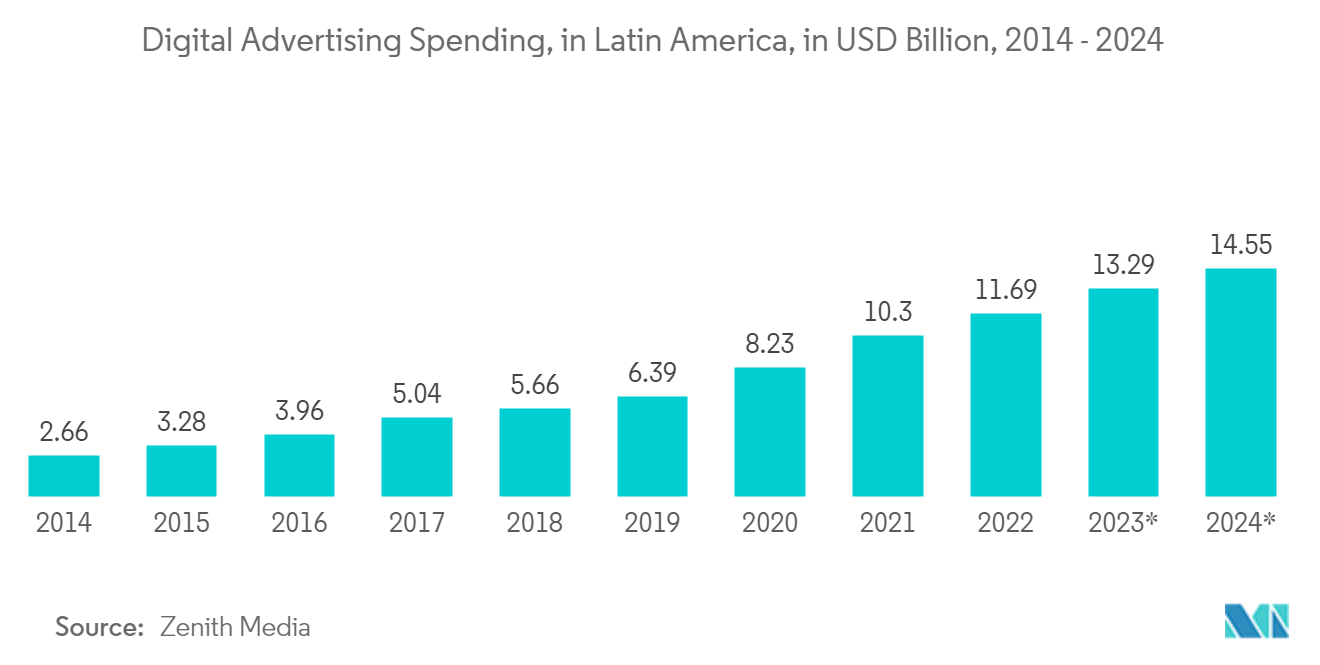
Brazil Holds Largest Market Share
- Brazil is one of the largest countries in Latin America. The country's business infrastructure is thriving as a result of the rising rate of urbanization, which increases the demand for digital signage solutions. For instance, according to the World Bank, in 2021, the degree of urbanization in Brazil was about 87.32 percent. As explanations for digital signage are essential for increasing communication efficacy, by using such solutions, end users can expand their reach in metropolitan regions to accommodate the expanding population in the area.
- Digitization has been a prevailing trend in Brazil, as the government is taking several initiatives to expand the digital infrastructure in the country. For instance, the Brazilian government has worked with Cisco for years to develop the networking infrastructure required to support digital solutions. Furthermore, according to EBC, a public communications company in Brazil, in 2021, the country rose five positions to be ranked as the second most advanced country in the field of digital government globally.
- Continuous investments are being made in the country to support this growth further. For instance, in September 2022, the Inter-American Development Bank (IDB) approved a loan worth USD 164 million to the State of São Paulo, Brazil, to help it advance the digital transformation process to improve the quality and efficiency of public services to citizens. Such trends create a favorable outlook for the growth of the market in the country.
- The increase in retail outlets and shopping malls in the country also drives demand for digital signage systems. According to the Brazilian Association of Shopping Centers (Abrasce), there were 620 malls in Brazil in 2022, and they collectively brought in close to BRL 160 billion (about USD 30.8 billion) in sales. Renner, C&A, Carrefour Hypermarket, Extra, Magazine Luiza, Casas Bahia, Drogasil, Droga Raia, and other major brands are among the top retailers in Brazil adopting digital advertising solutions. The current objective of Brazilian shopping centers is to give patrons an immersive experience by combining traditional and digital mall signage, which is anticipated to boost the market studied.
- The growing advertising expenditure is also among the major factors driving the growth of the digital signage market in Brazil. For instance, according to Magna, a leading medical investment company, Brazil had the highest advertising expenditure among Latin American countries.
- Digital signage is widely replacing traditional advertising methods owing to the various benefits they provide over traditional advertising methods. This is expected to drive the adoption of digital signage solutions in the advertising sector of the country.
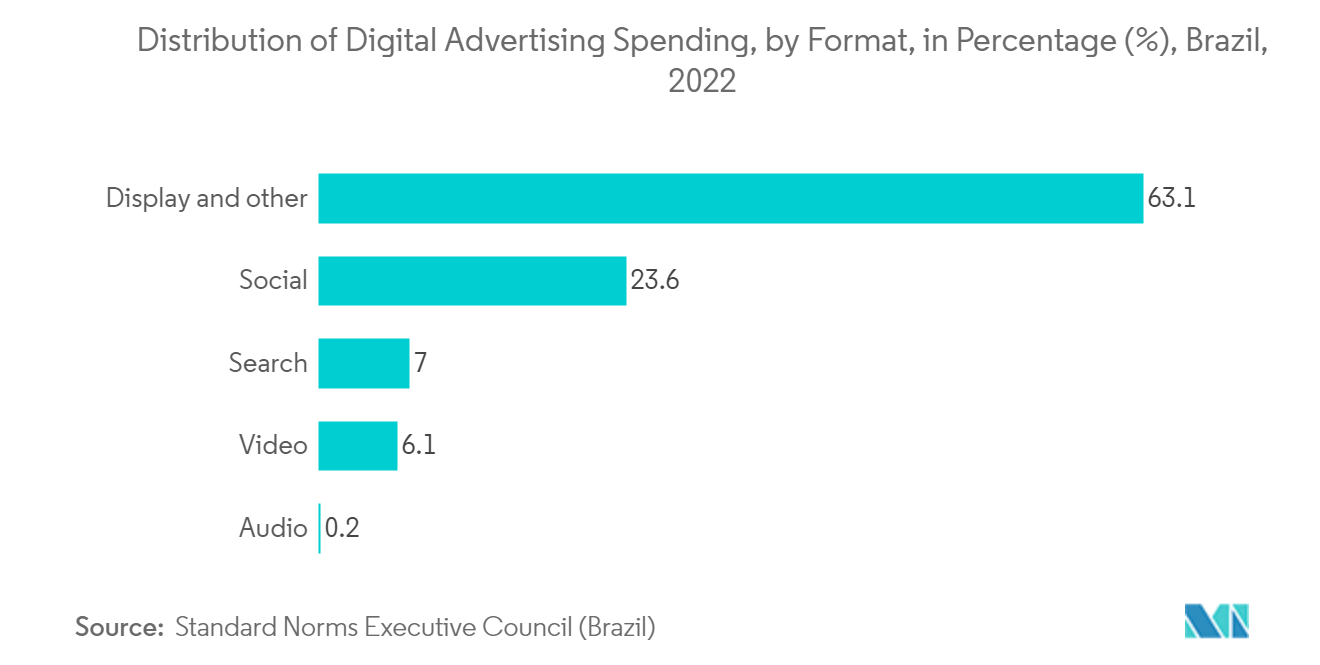
Latin America Digital Signage Industry Overview
The rising demand across various end users and the resultant increase in the opportunities for digital signage products are contributing to increased competition among the market players. Some of the major players in the Latin American digital signage market include Panasonic Corporation, LG Display Co. Ltd, Samsung Electronics Co. Ltd, Sony Corporation, and Sharp Corporation.
- In March 2023 - Hivestack announced a strategic partnership with Winkel Media, Latin America's first smart digital media and data analytics network, with over 5,000 screens located in prime retail stores across Peru, Mexico, Ecuador, and Columbia. Through this partnership, Winkel Media will integrate data-driven advanced DOOH inventory into the Hivestack Supply Side Platform (SSP) for advertisers across the globe to launch campaigns via both Open Exchange and Private Marketplace Deals (PMP).
- In February 2023 - NoviSign, a provider of digital signage software solutions, announced to expand of its presence in Costa Rica to support the growing Latin America Market. The company offers a complete set of web-based tools that give users everything they need to create and manage great digital signage.
Latin America Digital Signage Market Leaders
Panasonic Corporation
LG Display Co. Ltd
Samsung Electronics Co. Ltd
Sony Corporation
Sharp Corporation
*Disclaimer: Major Players sorted in no particular order
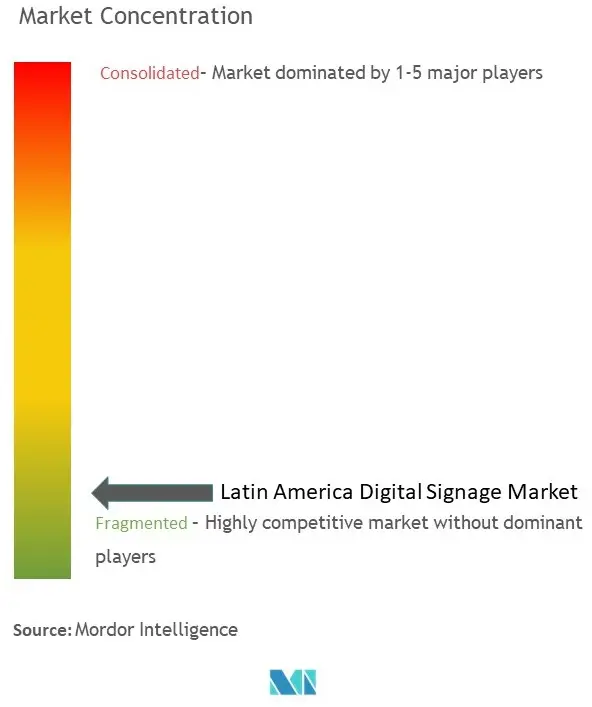
Latin America Digital Signage Market News
- Jan 2023 - Panasonic Corporation released its next-generation PT-REQ12 Series and PT-REZ12 Series 1-Chip DLP laser projectors to deliver never-before-seen experiences with up to 12,000 lm brightness, 4K3 resolution, and 240 Hz4 projection capability. This launch is during a time when the experience economy is rebounding, and the demand for immersive entertainment is on the rise.
- Jan 2023 - Broadsign International LLC announced the release of its next-generation OOH platform designed to help OOH media owners enhance operation, business management, and scalability. It will provide new flexible audience-targeting campaign tools with a unified user interface and expand static access to help media owners develop revenue opportunities and work more efficiently.
Latin America Digital Signage Market Report - Table of Contents
1. INTRODUCTION
1.1 Study Assumptions and Market Definition
1.2 Scope of the Study
2. RESEARCH METHODOLOGY
3. EXECUTIVE SUMMARY
4. MARKET INSIGHTS
4.1 Market Overview
4.2 Industry Attractiveness - Porter's Five Forces Analysis
4.2.1 Bargaining Power of Suppliers
4.2.2 Bargaining Power of Buyers
4.2.3 Threat of New Entrants
4.2.4 Threat of Substitutes
4.2.5 Degree of Competition
4.3 Industry Value Chain Analysis
4.4 Assessment of the Impact of COVID-19 on the Industry
5. MARKET DYNAMICS
5.1 Market Drivers
5.1.1 Gradual Increasing Pace of Digitization
5.2 Market Challenges
5.2.1 High Initial Cost of Innovation and Technical Complexity
6. TECHNOLOGY SNAPSHOT
6.1 Kiosk
6.2 Billboards
6.3 Menu Boards
6.4 Signboards
7. MARKET SEGMENTATION
7.1 By Type
7.1.1 Hardware
7.1.1.1 LCD/LED Display
7.1.1.2 OLED Display
7.1.1.3 Media Players
7.1.1.4 Projector/Projection Screens
7.1.1.5 Other Hardware
7.1.2 Software
7.1.3 Services
7.2 By End-user Industry
7.2.1 Retail
7.2.2 Transportation
7.2.3 Hospitality
7.2.4 Corporate
7.2.5 Government
7.2.6 Other End-user Industries
7.3 By Country
7.3.1 Brazil
7.3.2 Mexico
7.3.3 Argentina
7.3.4 Rest of Latin America
8. COMPETITIVE LANDSCAPE
8.1 Company Profiles
8.1.1 Panasonic Corporation
8.1.2 LG Display Co. Ltd
8.1.3 Samsung Electronics Co. Ltd
8.1.4 Sony Corporation
8.1.5 Sharp Corporation
8.1.6 3M Corporation
8.1.7 Scala Inc.
8.1.8 Cisco Systems Inc.
8.1.9 Broadsign International LLC
8.1.10 Omnivex Corporation
8.1.11 Stratacache Inc.
- *List Not Exhaustive
9. INVESTMENT ANALYSIS
10. FUTURE OF THE MARKET
Latin America Digital Signage Industry Segmentation
A digital signage system delivers and displays content, such as digital images, video, streaming media, and information. The displayed content is filed, and the schedule information is edited in the content management system. Digital signage, also known as dynamic signage, is a type of digital display that advertises broadcast information, television programming, and other content. Digital signs use a variety of technologies, including LED and LCD. They can be observed in both public and private spaces, such as eateries, shops, and workplaces.
The scope of the study includes the revenue accrued from the sales of digital signage in various types, such as hardware, software, and services. The market also includes the sales of digital signage in various end-user verticals such as retail, transportation, hospitality, corporates, and government. The scope of the study focuses on the market analysis of digital signage services sold across Latin America. The study tracks the key market parameters, underlying growth influencers, and major vendors operating in the industry, which supports the market estimations and growth rates during the forecast period. The study further analyzes the impact of COVID-19 on the ecosystem.
The Latin American digital signage market is segmented by type (hardware (LCD/LED display, OLED display, media players, projector/projection screens), software, and services), end-user industry (retail, transportation, hospitality, corporate, and government), and country (Brazil, Mexico, Argentina, and rest of Latin America). The market sizes and forecasts are provided in terms of value (USD) for all the above segments.
| By Type | |||||||
| |||||||
| Software | |||||||
| Services |
| By End-user Industry | |
| Retail | |
| Transportation | |
| Hospitality | |
| Corporate | |
| Government | |
| Other End-user Industries |
| By Country | |
| Brazil | |
| Mexico | |
| Argentina | |
| Rest of Latin America |
Latin America Digital Signage Market Research FAQs
How big is the LA Digital Signage Market?
The LA Digital Signage Market size is expected to reach USD 1.11 billion in 2024 and grow at a CAGR of 8.09% to reach USD 1.64 billion by 2029.
What is the current LA Digital Signage Market size?
In 2024, the LA Digital Signage Market size is expected to reach USD 1.11 billion.
Who are the key players in LA Digital Signage Market?
Panasonic Corporation, LG Display Co. Ltd , Samsung Electronics Co. Ltd , Sony Corporation and Sharp Corporation are the major companies operating in the LA Digital Signage Market.
What years does this LA Digital Signage Market cover, and what was the market size in 2023?
In 2023, the LA Digital Signage Market size was estimated at USD 1.03 billion. The report covers the LA Digital Signage Market historical market size for years: 2019, 2020, 2021, 2022 and 2023. The report also forecasts the LA Digital Signage Market size for years: 2024, 2025, 2026, 2027, 2028 and 2029.
LA Digital Signage Industry Report
Statistics for the 2024 Latin America Digital Signage market share, size and revenue growth rate, created by Mordor Intelligence™ Industry Reports. Latin America Digital Signage analysis includes a market forecast outlook to for 2024 to 2029 and historical overview. Get a sample of this industry analysis as a free report PDF download.
